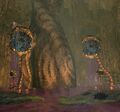Diababa
Template:Boss Twilit Parasite: Diababa is the boss of the first dungeon, the Forest Temple, in Twilight Princess. The boss itself is made up of two large plant heads that resemble Deku Babas and one massive plant head with a hidden eye inside its mouth. The appearance hints Diababa may have originally been a Deku Baba which touched the Fused Shadow.
Strategy
After Link enters Diababa's chamber, which is just a large room with four waterfalls and a large tree in a small pool of poisonous water, the water will start to bubble, and Diababa emerges from the water.
The beginning of the fight starts with only the two smaller heads. Bomblings can be seen perched on logs floating in the water, and the objective is to use the Gale Boomerang to make them collide with each of the two heads. A single hit will defeat each one. The heads will attack with a bite that is easy to anticipate.
The second phase of the fight begins when the larger head bursts out the water. After a few seconds, Ook appears and swings across the room carrying Bomblings for Link to use to stun Diababa's middle head, leaving its eye (the critical point) open for Link to attack with his sword. Upon recovering, Diababa sprays poison at Link, so he must move quickly to dodge it. The two smaller heads also continue to attack occasionally. Link can choose to defeat them, but the heads will regenerate. As Link continues dodging its attacks and repeats the process, Diababa is eventually defeated.
Upon Diababa's defeat, Link receives the first of the three Fused Shadows and a Heart Container.
Trivia
- Diababa is a portmanteau of "Diabolic" and "Baba", a common type of enemy.
- Diababa resembles Big Manhandla, the guardian of the Sea of Trees in Four Swords. It also has a slight resemblance to Kalle Demos from The Wind Waker.
- Inspiration for Diababa may have come from Flaahgra from Metroid Prime, a giant mutant plant who resides in polluted water; the two foes also share a battle strategy involving bomb-like attacks. Another possible inspiration is Biollante of the Godzilla film series.
- During the second half of the battle, Ook's theme can be heard, which is in turn based off of Saria's Song, making Diababa's theme somewhat based off of Saria's Song.
- When defeated, Diababa, along with Blizzeta, share a different "Boss Clear Fanfare" in comparison to the other bosses in Twilight Princess.
- After Link has defeated Diababa, if he returns to the boss room with the Iron Boots, he can sink to the bottom of the body of water where the boss was found. However, there's no solid surface on the bottom, so once he sinks far enough he will fade back to the entrance of the boss room.
Gallery
-
Diababa's first form
-
Diababa reveals its true form
-
Diababa's large central head and its tongue-like eye appendage
See also
| Language | Name | Meaning | |
|---|---|---|---|
| Japanese | Template:Japanese | Awoken Parasitic Species: Babarant | |
| FrenchEU | Dionéa, Mauvaise herbe du Crépuscule | Dionéa, Weed of Twilight | |
| German | Nachtschattenparasit Plantainferna | Nightshade parasite: Plantainferna | |
| Italian | Nefentyax, il parassita del crepuscolo | Nefentyax, The Parasite of the Twilight | |
| SpanishEU | Babalant, Parásito de las Sombras | Babalant, Parasite of the Shadows | |


